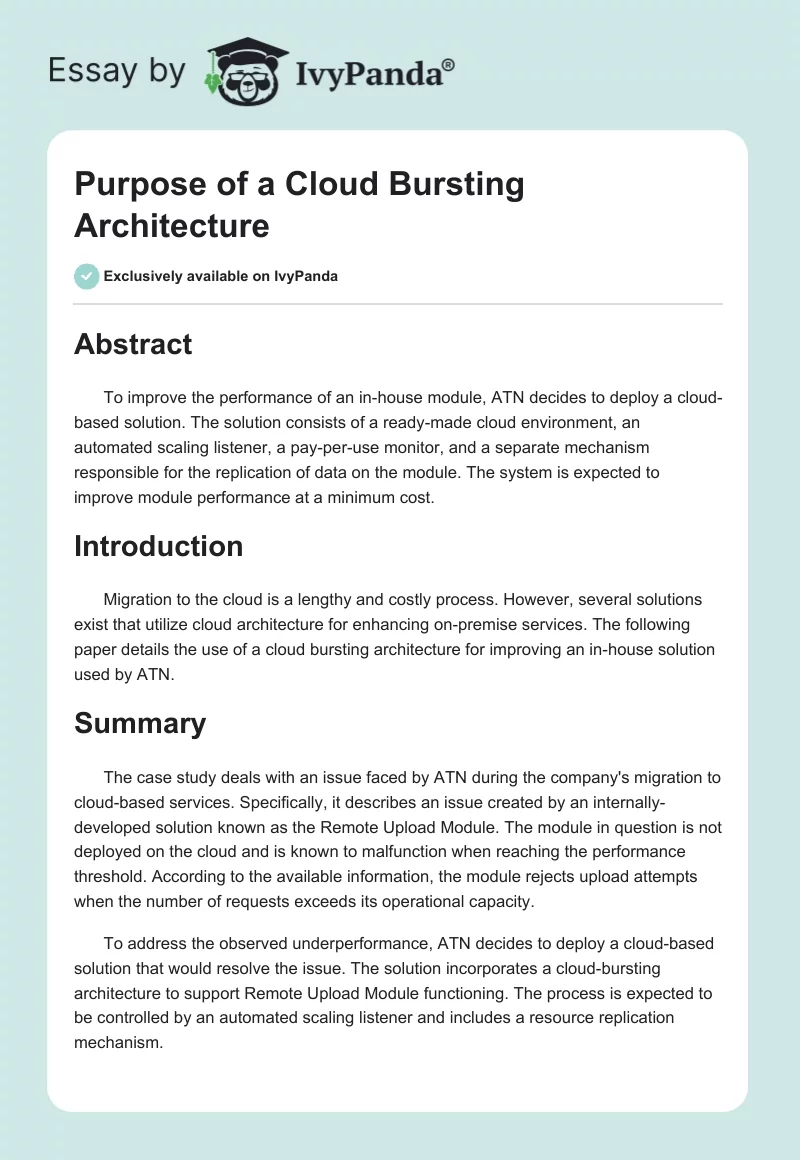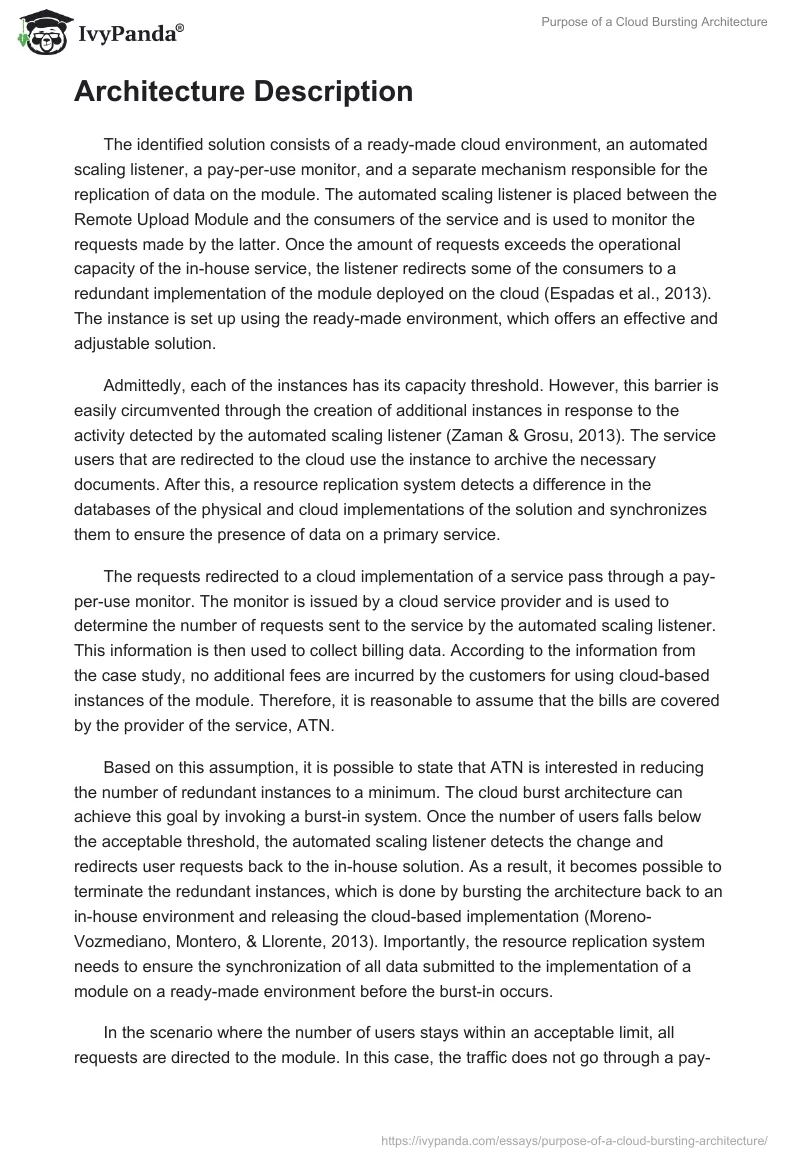Abstract
To improve the performance of an in-house module, ATN decides to deploy a cloud-based solution. The solution consists of a ready-made cloud environment, an automated scaling listener, a pay-per-use monitor, and a separate mechanism responsible for the replication of data on the module. The system is expected to improve module performance at a minimum cost.
Introduction
Migration to the cloud is a lengthy and costly process. However, several solutions exist that utilize cloud architecture for enhancing on-premise services. The following paper details the use of a cloud bursting architecture for improving an in-house solution used by ATN.
Summary
The case study deals with an issue faced by ATN during the company’s migration to cloud-based services. Specifically, it describes an issue created by an internally-developed solution known as the Remote Upload Module. The module in question is not deployed on the cloud and is known to malfunction when reaching the performance threshold. According to the available information, the module rejects upload attempts when the number of requests exceeds its operational capacity.
To address the observed underperformance, ATN decides to deploy a cloud-based solution that would resolve the issue. The solution incorporates a cloud-bursting architecture to support Remote Upload Module functioning. The process is expected to be controlled by an automated scaling listener and includes a resource replication mechanism.
Architecture Description
The identified solution consists of a ready-made cloud environment, an automated scaling listener, a pay-per-use monitor, and a separate mechanism responsible for the replication of data on the module. The automated scaling listener is placed between the Remote Upload Module and the consumers of the service and is used to monitor the requests made by the latter. Once the amount of requests exceeds the operational capacity of the in-house service, the listener redirects some of the consumers to a redundant implementation of the module deployed on the cloud (Espadas et al., 2013). The instance is set up using the ready-made environment, which offers an effective and adjustable solution.
Admittedly, each of the instances has its capacity threshold. However, this barrier is easily circumvented through the creation of additional instances in response to the activity detected by the automated scaling listener (Zaman & Grosu, 2013). The service users that are redirected to the cloud use the instance to archive the necessary documents. After this, a resource replication system detects a difference in the databases of the physical and cloud implementations of the solution and synchronizes them to ensure the presence of data on a primary service.
The requests redirected to a cloud implementation of a service pass through a pay-per-use monitor. The monitor is issued by a cloud service provider and is used to determine the number of requests sent to the service by the automated scaling listener. This information is then used to collect billing data. According to the information from the case study, no additional fees are incurred by the customers for using cloud-based instances of the module. Therefore, it is reasonable to assume that the bills are covered by the provider of the service, ATN.
Based on this assumption, it is possible to state that ATN is interested in reducing the number of redundant instances to a minimum. The cloud burst architecture can achieve this goal by invoking a burst-in system. Once the number of users falls below the acceptable threshold, the automated scaling listener detects the change and redirects user requests back to the in-house solution. As a result, it becomes possible to terminate the redundant instances, which is done by bursting the architecture back to an in-house environment and releasing the cloud-based implementation (Moreno-Vozmediano, Montero, & Llorente, 2013). Importantly, the resource replication system needs to ensure the synchronization of all data submitted to the implementation of a module on a ready-made environment before the burst-in occurs.
In the scenario where the number of users stays within an acceptable limit, all requests are directed to the module. In this case, the traffic does not go through a pay-per-use monitor, limiting the expenses incurred by the company. The ready-made environment where the virtual implementation of a module is hosted, as well as the on-demand resource replication system, remains idle. The user requests go directly to the Direct Upload Module, and the entire transaction is completed using ATN’s on-premise equipment.
Commercial Vendors
Several vendors on the market offer commercial products that can be used for the proposed solution. One example is the architecture proposed by F5. The provided documentation describes a setup similar to that described above, with automated distribution of traffic between the on-premise and cloud-hosted environment. The white paper does not mention either an automated scaling listener or a resource replication system. However, it does mention an automated application delivery network that is expected to contain the necessary services. Another example is the vCloud Architecture Toolkit offered by VMware, which allows creating a similar system for scaling purposes.
Conclusion
As can be seen, cloud bursting architecture offers a simple and cost-effective solution. The billing for ATN is reduced to occasional overload instances. The automated properties of the setup ensure seamless and reliable functioning. Finally, the pay-per-instance model keeps expenses at a minimum.
References
Espadas, J., Molina, A., Jiménez, G., Molina, M., Ramírez, R., & Concha, D. (2013). A tenant-based resource allocation model for scaling Software-as-a-Service applications over cloud computing infrastructures. Future Generation Computer Systems, 29(1), 273-286.
Moreno-Vozmediano, R., Montero, R. S., & Llorente, I. M. (2013). Key challenges in cloud computing: Enabling the future internet of services. IEEE Internet Computing, 17(4), 18-25.
Zaman, S., & Grosu, D. (2013). Combinatorial auction-based allocation of virtual machine instances in clouds. Journal of Parallel and Distributed Computing, 73(4), 495-508.


